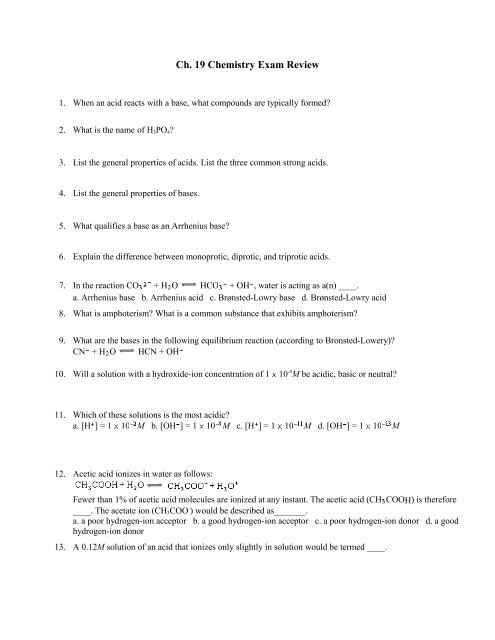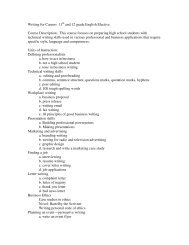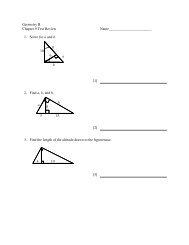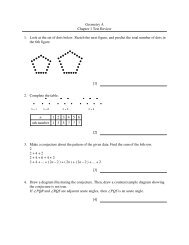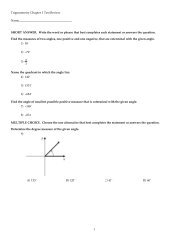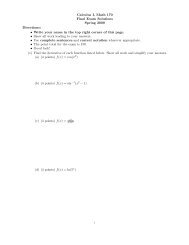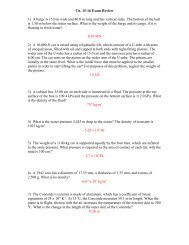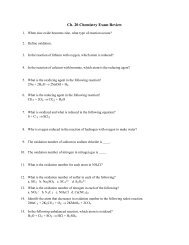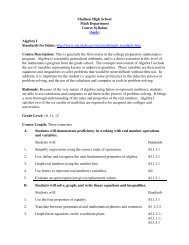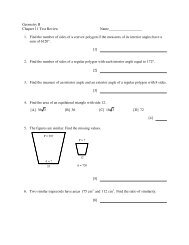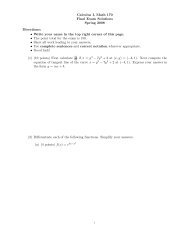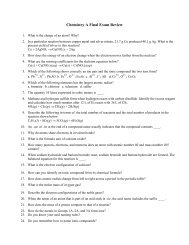Ch. 19 Chemistry Exam Review
Ch. 19 Chemistry Exam Review
Ch. 19 Chemistry Exam Review
You also want an ePaper? Increase the reach of your titles
YUMPU automatically turns print PDFs into web optimized ePapers that Google loves.
<strong>Ch</strong>. <strong>19</strong> <strong>Ch</strong>emistry <strong>Exam</strong> <strong>Review</strong><br />
1. When an acid reacts with a base, what compounds are typically formed?<br />
2. What is the name of H3PO4?<br />
3. List the general properties of acids. List the three common strong acids.<br />
4. List the general properties of bases.<br />
5. What qualifies a base as an Arrhenius base?<br />
6. Explain the difference between monoprotic, diprotic, and triprotic acids.<br />
7. In the reaction CO + H O HCO + OH , water is acting as a(n) ____.<br />
a. Arrhenius base b. Arrhenius acid c. Brønsted-Lowry base d. Brønsted-Lowry acid<br />
8. What is amphoterism? What is a common substance that exhibits amphoterism?<br />
9. What are the bases in the following equilibrium reaction (according to Bronsted-Lowery)?<br />
CN + H O HCN + OH<br />
10. Will a solution with a hydroxide-ion concentration of 1 10 -9 M be acidic, basic or neutral?<br />
11. Which of these solutions is the most acidic?<br />
a. [H ] = 1 10 M b. [OH ] = 1 10 M c. [H ] = 1 10 M d. [OH ] = 1 10 M<br />
12. Acetic acid ionizes in water as follows:<br />
Fewer than 1% of acetic acid molecules are ionized at any instant. The acetic acid (CH COOH) is therefore<br />
____. The acetate ion (CH3COO - ) would be described as_______.<br />
a. a poor hydrogen-ion acceptor b. a good hydrogen-ion acceptor c. a poor hydrogen-ion donor d. a good<br />
hydrogen-ion donor<br />
13. A 0.12M solution of an acid that ionizes only slightly in solution would be termed ____.
14. Which of the following pairs consists of a strong acid and a weak base?<br />
a. sulfuric acid, sodium hydroxide b. acetic acid, ammonia c. acetic acid, sodium hydroxide d. nitric acid,<br />
ammonia<br />
15. How is Ka calculated? What is the significance of Ka?<br />
16. The K of carbonic acid is 4.3 10 .<br />
H CO H + HCO<br />
This means that H CO is a ____.<br />
a. good hydrogen-ion acceptor b. poor hydrogen-ion acceptor c. good hydrogen-ion donor d. poor<br />
hydrogen-ion donor<br />
17. How can a base be strong, but never concentrated?<br />
18. How many moles of H2SO4 are required to neutralize 2.4 mol NaOH?<br />
<strong>19</strong>. Calculate the molarity of an HCl solution if 45.0 mL of the solution is neutralized by 15.5 mL of 0.600 M<br />
NaOH.<br />
20. What is a buffer made from?<br />
21. What is the hydroxide ion concentration in a solution that has a pH of 6.52?<br />
22. What is the molarity of an H2SO4 solution if 55.0 mL of the solution reacts completely with 0.365 g CaCO3?<br />
23. What is the pH of a solution that has a hydroxide ion concentration of 2.5 x 10 -6 ?<br />
24. What will be produced when calcium hydroxide reacts with hydrochloric acid?<br />
25. The pH of a 0.500 M HNO2 solution is 3.25. What is the Ka of this acid?


